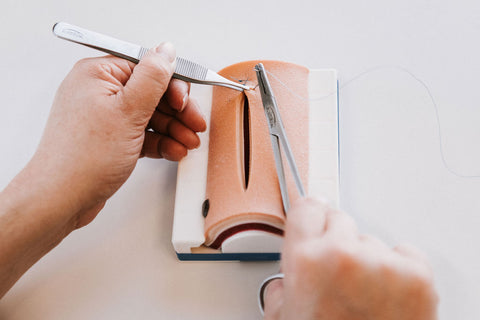

To learn more about our Small 6-Layer Suture Training Kit click here.
As a medical, PA, veterinary, nursing student or any medical professional performing suturing, the importance of practicing your suturing skills cannot be left to the wayside. Perfecting your suture techniques frequently throughout your time in school, and even during your professional career, will ensure that you score high on your clinical exams, and ultimately will provide the best service to your patients. With the myriad of choices available in suture kits, it can be tempting to resort to cheaper and less realistic materials. Nevertheless, this may eventually lead to greater costs and frustrations in the long-run. Here we will discuss the main reasons why one should invest in a quality suture kit in order to master the techniques of suturing. We use the word ‘invest’ because you will reap the benefits sooner or later.
TIME
By learning a skill set correctly the first time, you will in retrospect save a great amount of effort and time. Unlearning bad habits is not only difficult, but time-consuming as well. As succinctly put in an article in the Harvard Business Review, “Unlearning is not about forgetting. It’s about the ability to choose an alternative mental model or paradigm. […]The tendency will be to fall back into the old way of thinking and therefore the old way of doing” (Bonchek, 2016). When students practice on poor quality materials (such as bananas and pigs’ feet) the lack of textural reality akin to living human tissue can easily create poor habits that must be painstakingly undone later on. Consider also when you are faced with patients who require your imminent care—without proper technique and knowledge, higher incidence of infection, contamination, hernia, failure, complex scarring, multiple return visits could occur. Lest anyone should need to relearn these skill sets on live patients, the best thing would be to invest in the most realistic learning tools from the onset.
COST
Although low-grade practice materials may cost less upfront, there is a higher cost-per-suture when working with less realistic kits. This is due to the fact that poor quality suture kits degrade much more rapidly than quality ones, resulting in the need for students and institutions to purchase more. When thinking about one’s investment in studying in the medical field, you want to invest in the best learning tools so that you make the most of your effort, time and finances. Even for novice artists and painters, it is always recommended for them to purchase the highest quality material they can afford so their progress is not stunted due to insufficient cheap materials. Most importantly, let us be mindful that ultimately the cost will fall on our patients’ health, recovery, time and morale, should we fail to offer them the highest quality health service.
DISADVANTAGES OF LESS REALISTIC MATERIALS
A quick search on the internet for materials to practice suturing most often leads to using fruits such as bananas and oranges, pigs’ feet, chicken thighs, sponges and cadavers.
- The benefit of using fruits is that they are cheap and readily available. Unfortunately, they lack layers and are far from the texture and integrity of real skin. It may be an easy go-to for the first few tries as you learn to grasp the needle holder and develop the techniques, but you do not want to keep practicing on bananas when there are far better options out there to hone your skills.
- As for pigs’ feet – yes, it is real tissue and has different dermal layers. However, because it is not live tissue, the moisture level is significantly lower. This results in a very different tactile experience from living tissue. Suture practice on pigs’ feet could result in students exerting too much pressure on live patients due to poor habits. Material procurement and upkeep can also be a challenge (keeping them frozen and defrosting in time) – not to mention the clean up afterwards.
- Practicing on chicken thighs poses several challenges to learning to suture, as the skin on the thighs can be quite flimsy and mobile. The relative ease with which you can peel off chicken skin is unrepresentative of live human tissue. There is also very limited number of stitches you can make on animal specimen, 30-45 sutures at most, hence limiting experiential exposure.
- Although cadavers are one of the better materials to practice on, as they do provide for a better simulative experience. The downside here is their leathery feel caused by formaldehyde, which is far removed from live tissue and can easily hinders students’ learning progress.
- Practicing on silicon suture kits is a close second to suturing on live tissue, assuming a quality suture pad is used. Quality kits will provide the different dermal layers and the proper feel. You will be able to visually and proprioceptively verify if you have reached the correct layers. Before you have the confidence of stitching up your patients, you will want to have mastered the basics. And the best thing about quality suture kits is that you can practice hundreds of times on them anytime anywhere. https://surgireal.com/collections/suture-pads/products/small-6-layer-suture-pad
TECHNIQUE AND CONFIDENCE
The degree of your confidence, competence and empowerment is in direct correlation with the extent of your technical suturing skills. Studies have shown that medical simulation-based training and practice serve to enhance subsequent clinical competence (Al-Elq, 2010). The application of theoretical knowledge must be translated into practical clinical skills when students in the medical field encounter their patients. This is not always as simple as it may seem. Given the opportunity to apply your first suture skills on a live patient, your head may be spinning from all the quick decisions you must make on the spot, such as how to prepare the skin, where to administer the anaesthesia, which type of suture thread to use (absorbable or non-absorbable), which needle size, and of course choosing between the plethora of suture techniques. As you are busy performing an interrupted horizontal mattress suture on your patient’s abdominal cavity, you will be glad to have your muscle memory come to aid you in reaching just the right layers. When student practitioners practice on unrepresentative tissue and develop bad habits, they will find themselves in difficult situations where their competence and confidence will easily wane in the face of real scenarios.
Proper medical training with the most realistic simulation tools will likely improve patient outcome, reduce healthcare expenditure and lower the number of medical error incidence occurring in 3% of hospital patients (Kohn, Corrigan & Donaldson, 1999). This is why the best tools for the most realistic suture training and learning are made available to institutions and individuals in the medical field. A quality suture kit is a very small investment compared to how much you have already put into your education. When you are finally in the OR, you will not regret ditching the bananas and pigs’ feet in exchange for something much closer to real skin and flesh.
To learn more about our Small 6-Layer Suture Training Kit click here.
REFERENCES
- Al-Elq, A. H. (2010). Simulation-based medical teaching and learning. J Family Community Med; 17:35-40.
- Bonchek, M. (2016). Why the Problem with Learning is Unlearning. Harvard Business Review. https://hbr.org/2016/11/why-the-problem-with-learning-is-unlearning.
- Kohn, L. T., Corrigan, J. M., Donaldson, M. S. (1999). To err is human: Building a safer health system. Washington DC: National Academy Press.
